Developing Strategies: A Game Design for Avoiding Plagiarism
VerifiedAdded on 2023/06/17
|7
|979
|251
Report
AI Summary
This report outlines the design of a game, specifically a Ludo adaptation, aimed at educating students about academic integrity, plagiarism, and academic misconduct. The game incorporates elements where students learn about these concepts based on the roll of a dice, with each number corresponding to information about academic integrity, misconduct, or plagiarism. The design process involves concept selection, resource gathering, game construction with specific rules and informative content, testing, and finally, implementation for student learning. The report concludes that such games can effectively enhance students' knowledge and skills related to avoiding academic dishonesty, while also developing skills such as communication, decision-making, and creativity. Task 2 is covered in the poster.
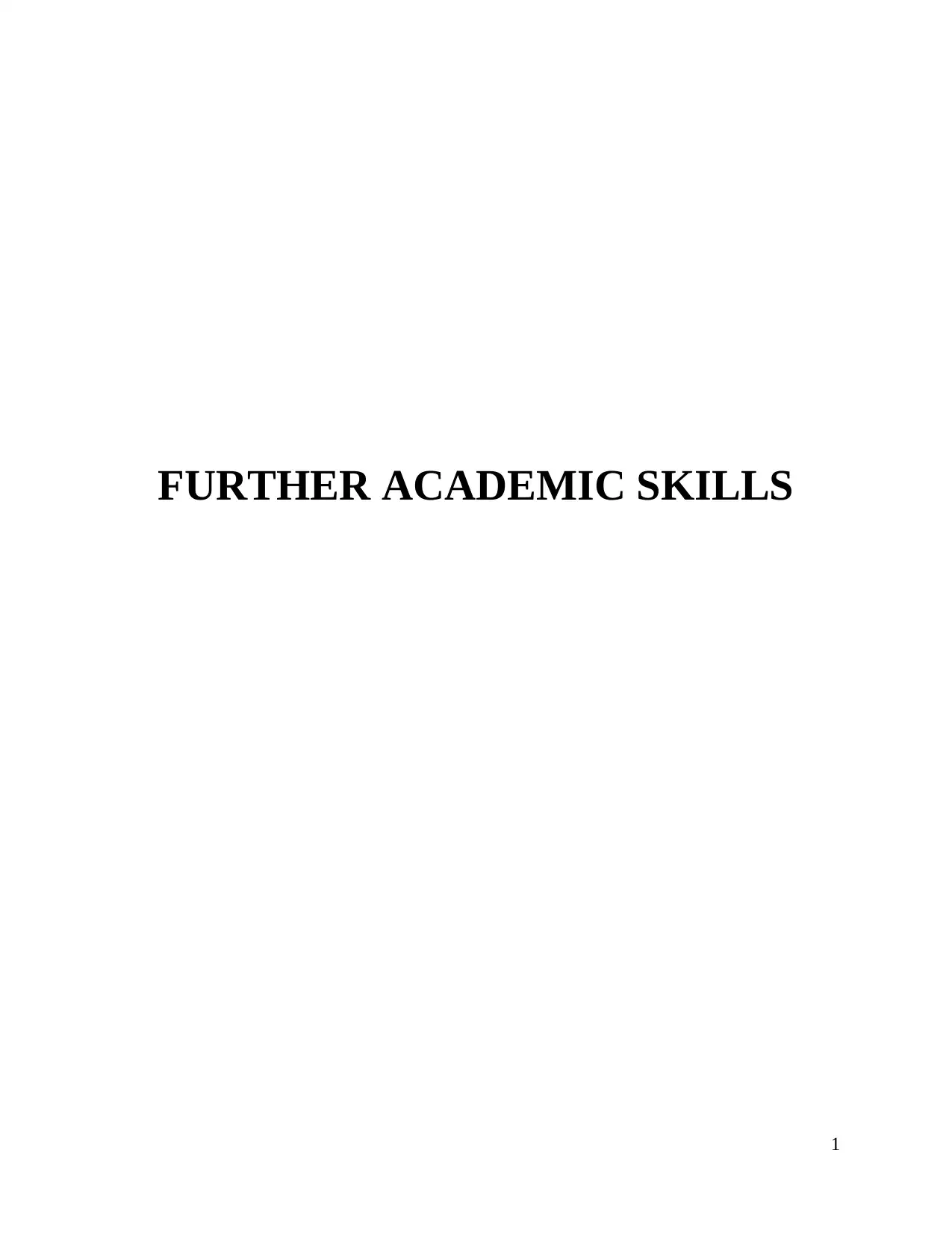
FURTHER ACADEMIC SKILLS
1
1
Paraphrase This Document
Need a fresh take? Get an instant paraphrase of this document with our AI Paraphraser
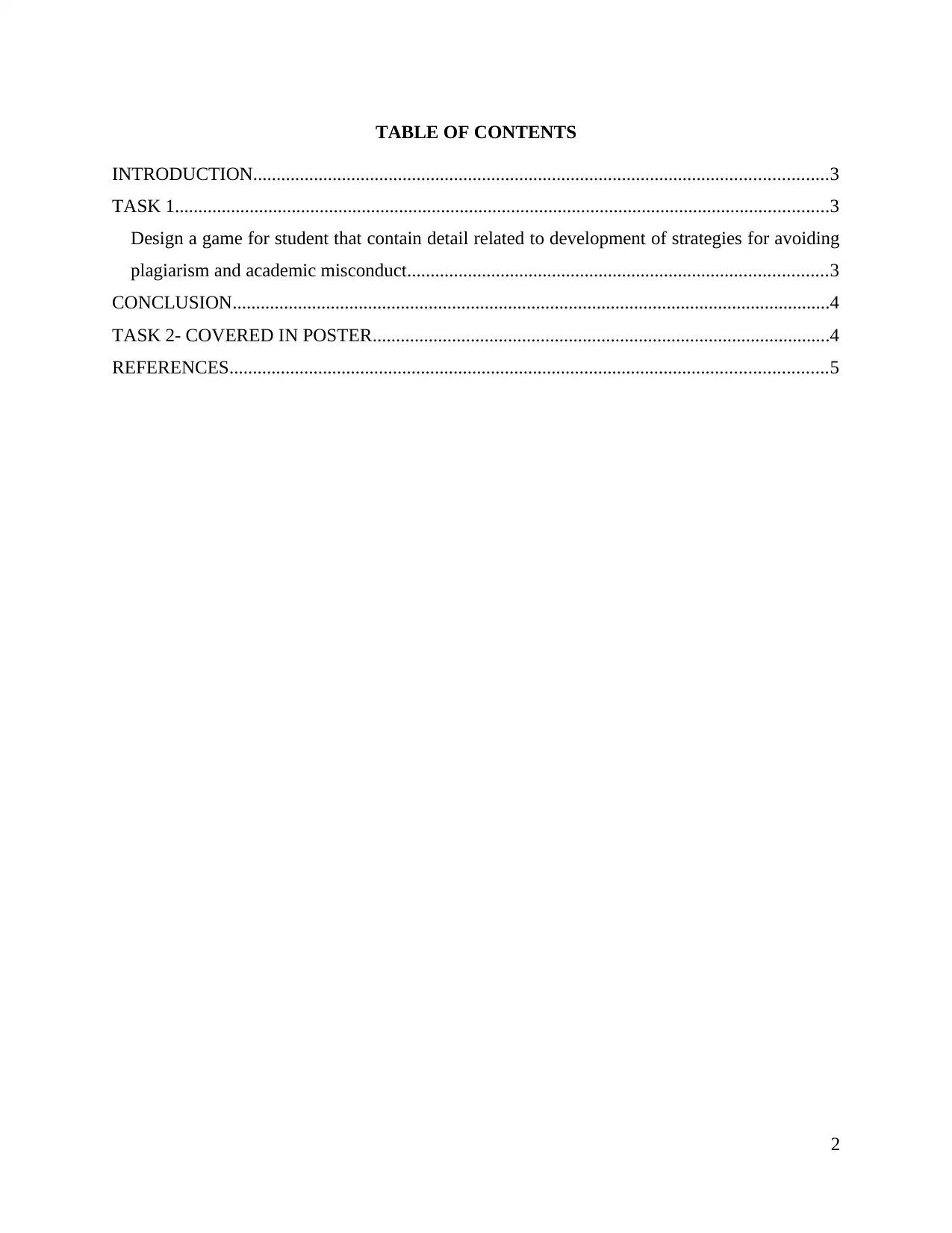
TABLE OF CONTENTS
INTRODUCTION...........................................................................................................................3
TASK 1............................................................................................................................................3
Design a game for student that contain detail related to development of strategies for avoiding
plagiarism and academic misconduct..........................................................................................3
CONCLUSION................................................................................................................................4
TASK 2- COVERED IN POSTER..................................................................................................4
REFERENCES................................................................................................................................5
2
INTRODUCTION...........................................................................................................................3
TASK 1............................................................................................................................................3
Design a game for student that contain detail related to development of strategies for avoiding
plagiarism and academic misconduct..........................................................................................3
CONCLUSION................................................................................................................................4
TASK 2- COVERED IN POSTER..................................................................................................4
REFERENCES................................................................................................................................5
2
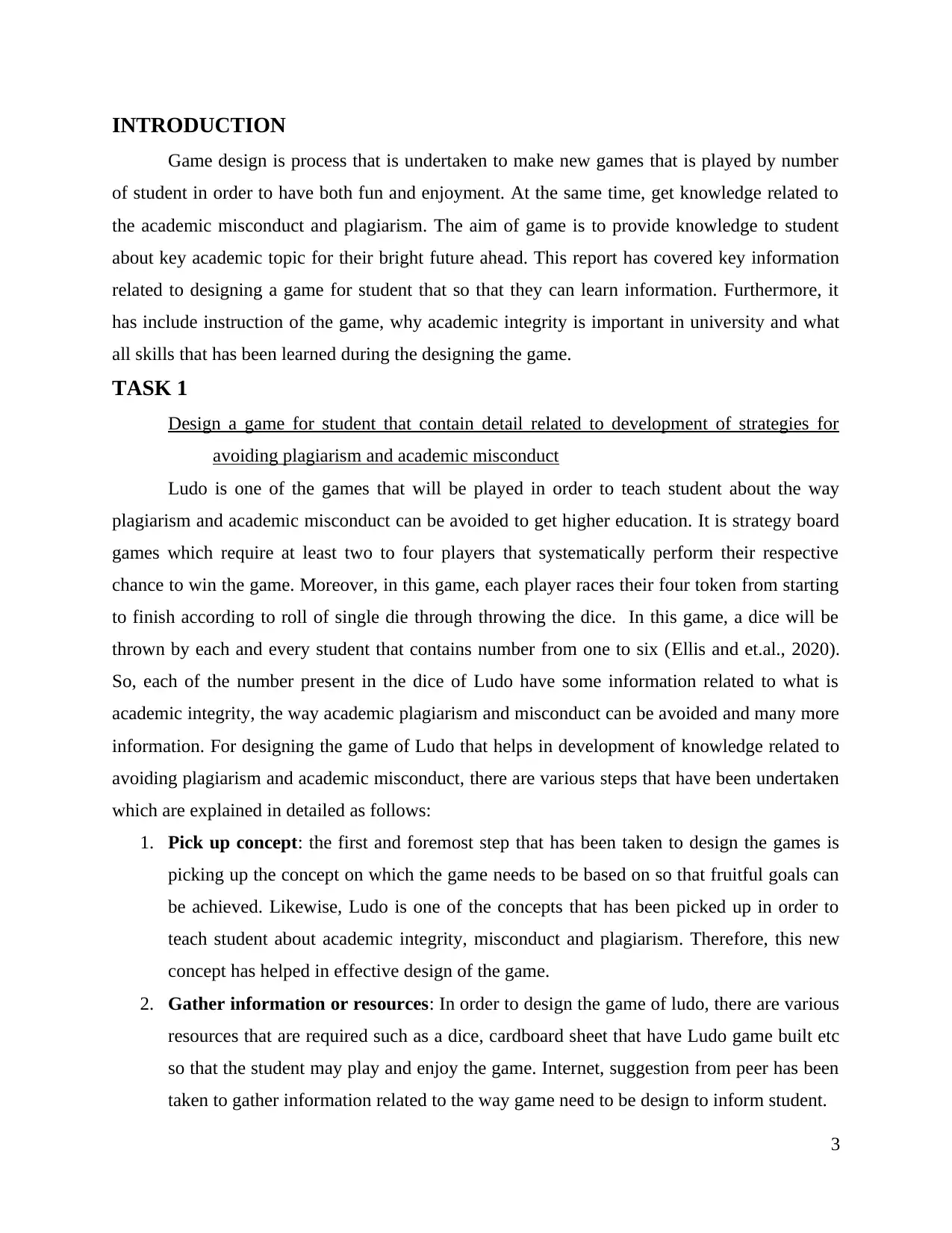
INTRODUCTION
Game design is process that is undertaken to make new games that is played by number
of student in order to have both fun and enjoyment. At the same time, get knowledge related to
the academic misconduct and plagiarism. The aim of game is to provide knowledge to student
about key academic topic for their bright future ahead. This report has covered key information
related to designing a game for student that so that they can learn information. Furthermore, it
has include instruction of the game, why academic integrity is important in university and what
all skills that has been learned during the designing the game.
TASK 1
Design a game for student that contain detail related to development of strategies for
avoiding plagiarism and academic misconduct
Ludo is one of the games that will be played in order to teach student about the way
plagiarism and academic misconduct can be avoided to get higher education. It is strategy board
games which require at least two to four players that systematically perform their respective
chance to win the game. Moreover, in this game, each player races their four token from starting
to finish according to roll of single die through throwing the dice. In this game, a dice will be
thrown by each and every student that contains number from one to six (Ellis and et.al., 2020).
So, each of the number present in the dice of Ludo have some information related to what is
academic integrity, the way academic plagiarism and misconduct can be avoided and many more
information. For designing the game of Ludo that helps in development of knowledge related to
avoiding plagiarism and academic misconduct, there are various steps that have been undertaken
which are explained in detailed as follows:
1. Pick up concept: the first and foremost step that has been taken to design the games is
picking up the concept on which the game needs to be based on so that fruitful goals can
be achieved. Likewise, Ludo is one of the concepts that has been picked up in order to
teach student about academic integrity, misconduct and plagiarism. Therefore, this new
concept has helped in effective design of the game.
2. Gather information or resources: In order to design the game of ludo, there are various
resources that are required such as a dice, cardboard sheet that have Ludo game built etc
so that the student may play and enjoy the game. Internet, suggestion from peer has been
taken to gather information related to the way game need to be design to inform student.
3
Game design is process that is undertaken to make new games that is played by number
of student in order to have both fun and enjoyment. At the same time, get knowledge related to
the academic misconduct and plagiarism. The aim of game is to provide knowledge to student
about key academic topic for their bright future ahead. This report has covered key information
related to designing a game for student that so that they can learn information. Furthermore, it
has include instruction of the game, why academic integrity is important in university and what
all skills that has been learned during the designing the game.
TASK 1
Design a game for student that contain detail related to development of strategies for
avoiding plagiarism and academic misconduct
Ludo is one of the games that will be played in order to teach student about the way
plagiarism and academic misconduct can be avoided to get higher education. It is strategy board
games which require at least two to four players that systematically perform their respective
chance to win the game. Moreover, in this game, each player races their four token from starting
to finish according to roll of single die through throwing the dice. In this game, a dice will be
thrown by each and every student that contains number from one to six (Ellis and et.al., 2020).
So, each of the number present in the dice of Ludo have some information related to what is
academic integrity, the way academic plagiarism and misconduct can be avoided and many more
information. For designing the game of Ludo that helps in development of knowledge related to
avoiding plagiarism and academic misconduct, there are various steps that have been undertaken
which are explained in detailed as follows:
1. Pick up concept: the first and foremost step that has been taken to design the games is
picking up the concept on which the game needs to be based on so that fruitful goals can
be achieved. Likewise, Ludo is one of the concepts that has been picked up in order to
teach student about academic integrity, misconduct and plagiarism. Therefore, this new
concept has helped in effective design of the game.
2. Gather information or resources: In order to design the game of ludo, there are various
resources that are required such as a dice, cardboard sheet that have Ludo game built etc
so that the student may play and enjoy the game. Internet, suggestion from peer has been
taken to gather information related to the way game need to be design to inform student.
3
⊘ This is a preview!⊘
Do you want full access?
Subscribe today to unlock all pages.

Trusted by 1+ million students worldwide
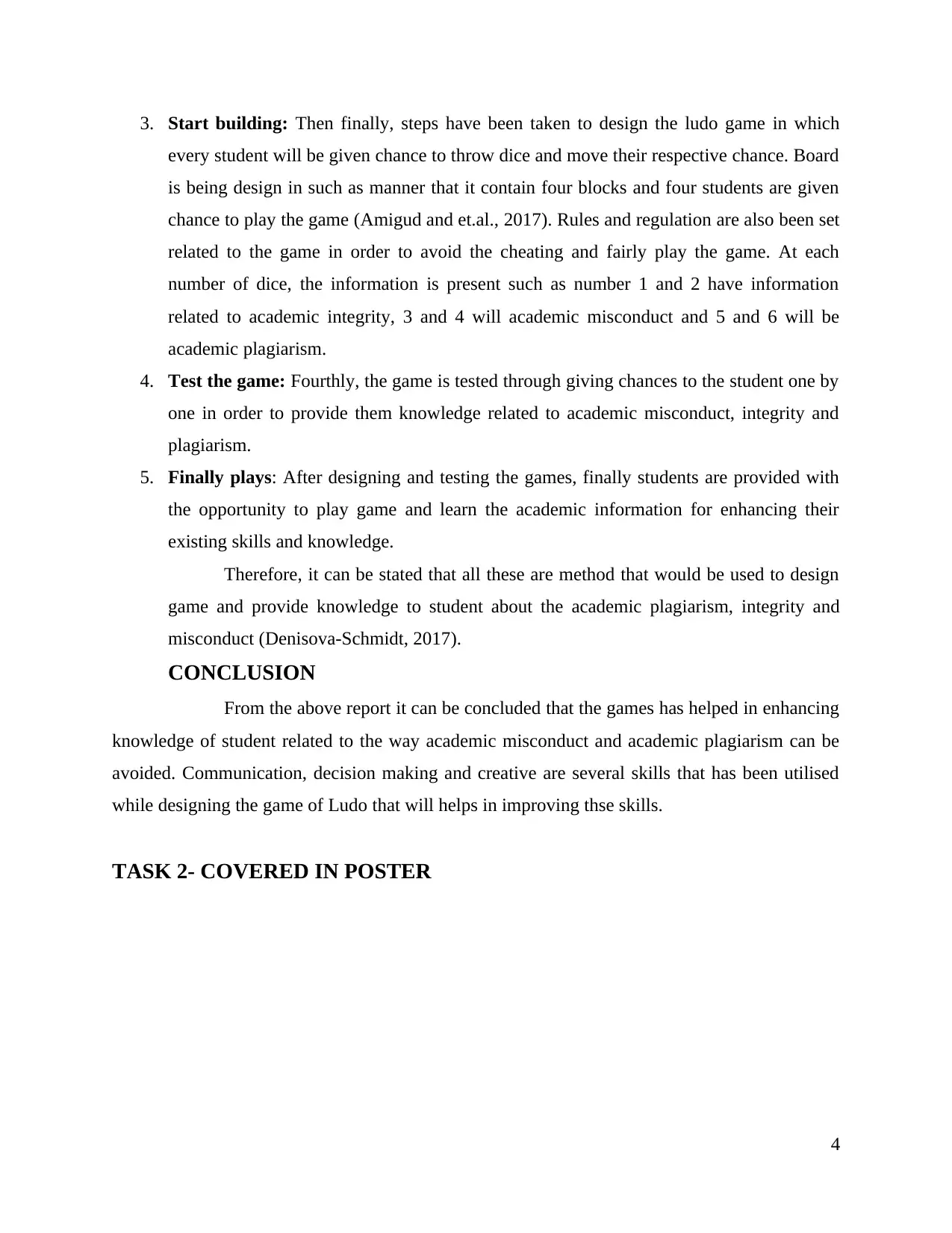
3. Start building: Then finally, steps have been taken to design the ludo game in which
every student will be given chance to throw dice and move their respective chance. Board
is being design in such as manner that it contain four blocks and four students are given
chance to play the game (Amigud and et.al., 2017). Rules and regulation are also been set
related to the game in order to avoid the cheating and fairly play the game. At each
number of dice, the information is present such as number 1 and 2 have information
related to academic integrity, 3 and 4 will academic misconduct and 5 and 6 will be
academic plagiarism.
4. Test the game: Fourthly, the game is tested through giving chances to the student one by
one in order to provide them knowledge related to academic misconduct, integrity and
plagiarism.
5. Finally plays: After designing and testing the games, finally students are provided with
the opportunity to play game and learn the academic information for enhancing their
existing skills and knowledge.
Therefore, it can be stated that all these are method that would be used to design
game and provide knowledge to student about the academic plagiarism, integrity and
misconduct (Denisova-Schmidt, 2017).
CONCLUSION
From the above report it can be concluded that the games has helped in enhancing
knowledge of student related to the way academic misconduct and academic plagiarism can be
avoided. Communication, decision making and creative are several skills that has been utilised
while designing the game of Ludo that will helps in improving thse skills.
TASK 2- COVERED IN POSTER
4
every student will be given chance to throw dice and move their respective chance. Board
is being design in such as manner that it contain four blocks and four students are given
chance to play the game (Amigud and et.al., 2017). Rules and regulation are also been set
related to the game in order to avoid the cheating and fairly play the game. At each
number of dice, the information is present such as number 1 and 2 have information
related to academic integrity, 3 and 4 will academic misconduct and 5 and 6 will be
academic plagiarism.
4. Test the game: Fourthly, the game is tested through giving chances to the student one by
one in order to provide them knowledge related to academic misconduct, integrity and
plagiarism.
5. Finally plays: After designing and testing the games, finally students are provided with
the opportunity to play game and learn the academic information for enhancing their
existing skills and knowledge.
Therefore, it can be stated that all these are method that would be used to design
game and provide knowledge to student about the academic plagiarism, integrity and
misconduct (Denisova-Schmidt, 2017).
CONCLUSION
From the above report it can be concluded that the games has helped in enhancing
knowledge of student related to the way academic misconduct and academic plagiarism can be
avoided. Communication, decision making and creative are several skills that has been utilised
while designing the game of Ludo that will helps in improving thse skills.
TASK 2- COVERED IN POSTER
4
Paraphrase This Document
Need a fresh take? Get an instant paraphrase of this document with our AI Paraphraser
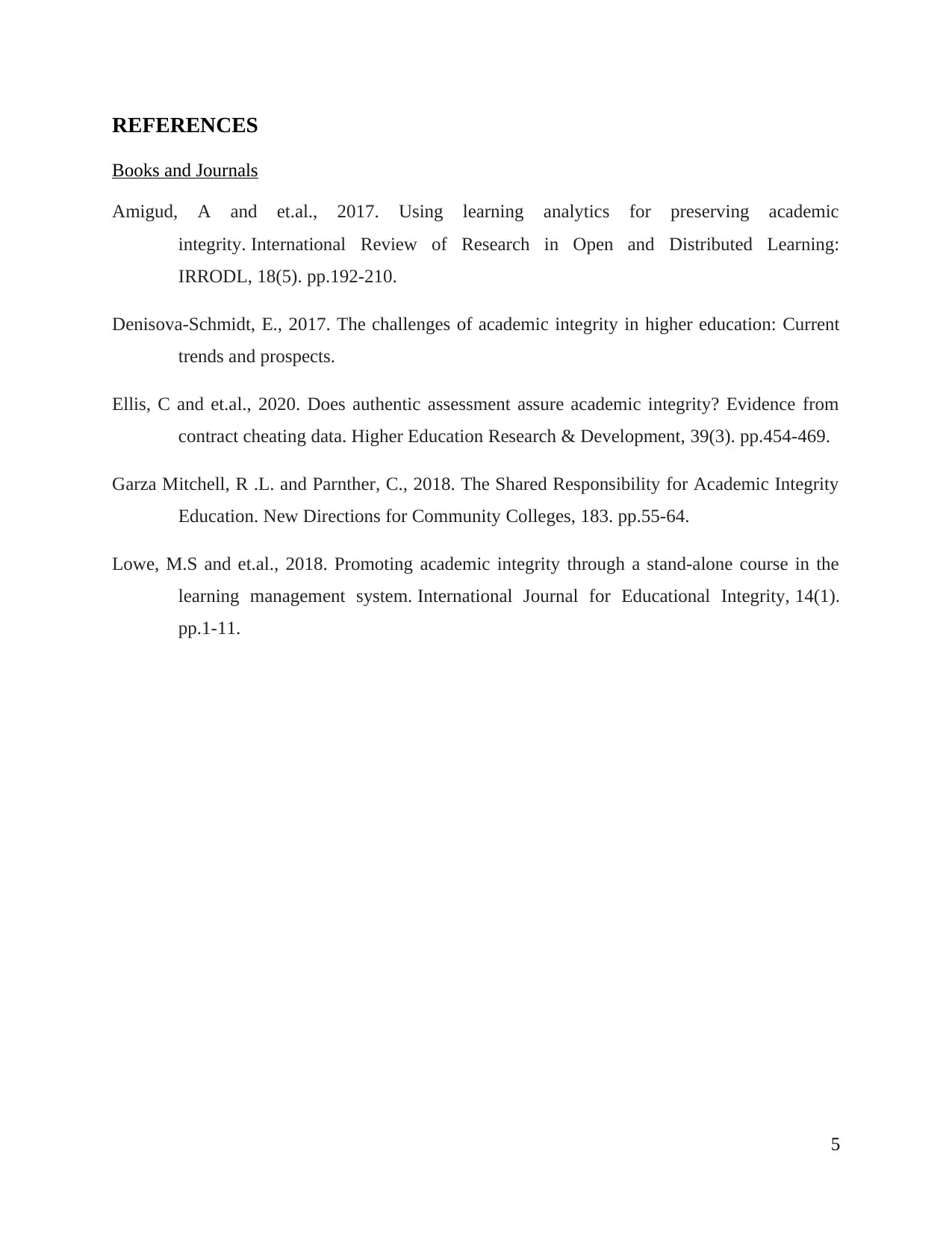
REFERENCES
Books and Journals
Amigud, A and et.al., 2017. Using learning analytics for preserving academic
integrity. International Review of Research in Open and Distributed Learning:
IRRODL, 18(5). pp.192-210.
Denisova-Schmidt, E., 2017. The challenges of academic integrity in higher education: Current
trends and prospects.
Ellis, C and et.al., 2020. Does authentic assessment assure academic integrity? Evidence from
contract cheating data. Higher Education Research & Development, 39(3). pp.454-469.
Garza Mitchell, R .L. and Parnther, C., 2018. The Shared Responsibility for Academic Integrity
Education. New Directions for Community Colleges, 183. pp.55-64.
Lowe, M.S and et.al., 2018. Promoting academic integrity through a stand-alone course in the
learning management system. International Journal for Educational Integrity, 14(1).
pp.1-11.
5
Books and Journals
Amigud, A and et.al., 2017. Using learning analytics for preserving academic
integrity. International Review of Research in Open and Distributed Learning:
IRRODL, 18(5). pp.192-210.
Denisova-Schmidt, E., 2017. The challenges of academic integrity in higher education: Current
trends and prospects.
Ellis, C and et.al., 2020. Does authentic assessment assure academic integrity? Evidence from
contract cheating data. Higher Education Research & Development, 39(3). pp.454-469.
Garza Mitchell, R .L. and Parnther, C., 2018. The Shared Responsibility for Academic Integrity
Education. New Directions for Community Colleges, 183. pp.55-64.
Lowe, M.S and et.al., 2018. Promoting academic integrity through a stand-alone course in the
learning management system. International Journal for Educational Integrity, 14(1).
pp.1-11.
5

6
⊘ This is a preview!⊘
Do you want full access?
Subscribe today to unlock all pages.

Trusted by 1+ million students worldwide

7
1 out of 7
Related Documents
Your All-in-One AI-Powered Toolkit for Academic Success.
+13062052269
info@desklib.com
Available 24*7 on WhatsApp / Email
![[object Object]](/_next/static/media/star-bottom.7253800d.svg)
Unlock your academic potential
Copyright © 2020–2025 A2Z Services. All Rights Reserved. Developed and managed by ZUCOL.




